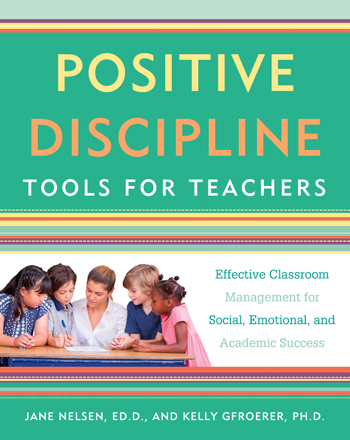Below is an excerpt from the book, Positive Discipline Tools for Teachers by Dr. Jane Nelsen and Dr. Kelly Gfroerer.
Do you sometimes have the feeling that your students don’t hear a word you say? You are probably right—especially when a mistaken goal is involved. For example, if a student’s mistaken goal is Undue Attention and you try to motivate behavior change through verbal lectures or reprimands, you are actually reinforcing the student’s goal of seeking attention as his or her mistaken way to find belonging and significance.
If your student’s mistaken goal is Misguided Power, your words may invite a power struggle as he or she lets you know, “You can’t make me.” If your student’s goal is Revenge, your words are likely to deepen his or her hurt feelings and invite more hurtful behavior in retaliation. If your student’s mistaken goal is Assumed Inadequacy, your words are likely to deepen his or her mistaken belief of not being good enough. Too often the words you use are based on reacting to the behavior. Acting without words requires that you stop and think about how to respond proactively. It requires you to get into the student’s world and understand the belief behind the behavior so that you can encourage new beliefs that motivate new behavior.
Using nonverbal signals is one way to act without words, and may help to get your students involved. During class meetings, have students brainstorm a list of silent nonverbal signals that are respectful and helpful. Some examples: smile and point to what needs to be done; hold up an index finger as a reminder to use quiet voices; clap three times and have the student echo these claps as a reminder for silence. Nonverbal signals are always more effective if students are involved in creating those signals and agreeing to them in advance.
Sometimes acting without words isn’t appropriate or helpful in the situation. Another Positive Discipline teacher tool related to Act Without Words is the One Word tool. In that case, the signal is replaced by one word. The last “Tool in Action” story shared in this section includes a teacher success story using this tool. The “Tool Tips” section provides specific examples to show how using one word may be most effective.
Finally, there are times when the most effective thing to do is to get close to a student who is off-task. Your proximity alone may be all the student needs to get back on task—especially if your intent and energy convey connection before correction rather than intimidation. It is often said that actions speak louder than words, but the energy behind those actions has the loudest “voice” of all. You will feel the energy of the teacher who shares this in the following “Tool in Action” story.
Success Story
In large urban high schools of more than two thousand students, the process of changing classes creates repeated, disruptive events throughout the school day. Although changing classes has the positive benefits of giving students regular breaks and needed interaction with their peers, these short periods of heightened social and physical activity can make it difficult for teenagers to transition to the calm of class discussions and instruction. When thirty or more vivacious teens enter a high school classroom, they inevitably collect in small social groups and continue their hall- way discussions. The teacher has the challenge of gaining their attention quickly so that the work of the day can begin. When the ringing of the automated school bell is not enough, I try to model polite interruption, since the social exchange among peers is of utmost importance to these adolescents.
Instead of attempting to make myself heard above the noise of thirty teenage voices, I walk over to the light switch and turn the lights on and off several times to signal to students that I’m ready for class to begin. They have learned what this signal means, they can all see it happening, and they know they need to bring their conversations to an end, take their seats, and listen for instructions. Without speaking a word, I have their attention. Equally effective is the device of raising my hand in the air as I place a finger over my lips. I find a small group of students who are watching me and perform this action with them first. These students know it is time to end conversation, and they raise their hands as well. Gradually I move from group to group, not saying a word but simply keeping my hand raised. If necessary, I do the “zip your lips” motion. Without one word spoken about the need for quiet, the teacher can begin.
—Sally Humble, Ph.D., retired English teacher, College Board Workshop facilitator/consultant


